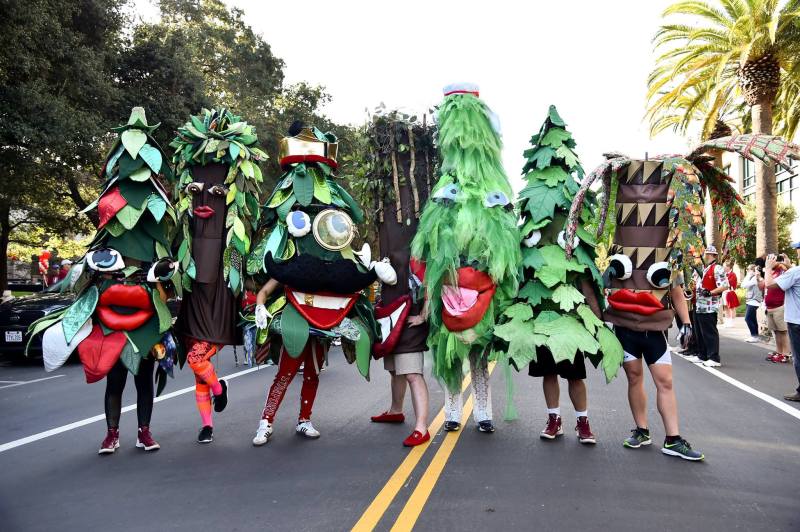Over the past two years, former Tree costumes have been moved from the Band Shack to the Stanford University Archives in Green Library.
Intended to preserve the costumes — a new version of which is made each year by the Leland Stanford Junior Marching Band mascot — the archives’ collection of Trees remains accessible to members of the Band.
Sam Weyen ’18, who was the Tree during the 2016-2017 academic year, was inspired to preserve the costumes when he saw them deteriorating in the Band Shack.
“I thought it was sad that we had so many Trees crammed into this horrible closet in the Band Shack because a Tree either needs to go out in a giant ball of flame or it should be worn by future Trees who want to get a sense of what the costume means and experience history,” Weyen said, referencing the tradition of burning one’s Tree costume at the end of one’s reign.
Dahkota Brown ’20, the current Tree, agreed that the costumes should be preserved.
“We get a lot of love, we get a lot of hate, but the Tree is something that’s just really special to this University, and being able to save those parts of our history is really important,” he said.
University archivist Daniel Hartwig emphasized that current and past Trees retain full access to the costumes and are encouraged to check them out for Homecoming Weekend Band events.
“Normally, archives are just used in the reading room or require special access, but these were costumes that were meant to be used, to be performed in, and they’re part of the Band,” Hartwig said.
Ensuring that the Band maintained full access to the Tree costumes was especially important to Weyen when he first initiated the preservation project in 2016.
That year, the University’s Organizational Conduct Board suspended the Band for violations of University policies. Fearing that the Band could be permanently disbanded as a student-run organization, Band members sought to preserve items still in the Band Shack.
“We thought it might be better to preserve the Trees in a way that guaranteed that the Band would have authority over them,” Weyen explained.
Besides serving as the Band’s repository for retired Tree costumes, the archives also aim to document the history of the Stanford Band. Tree costumes join the 152,095 photographs, recordings and other Band memorabilia that the University Archives have already collected.
The University Archives are in the process of photographing and scanning the Tree costumes to make them accessible virtually.
“Although the archives’ focus is teaching, learning and research, we also want to preserve and provide access to other elements of Stanford, including student life, with the Band being one of the main examples of that,” Hartwig said.
Weyen remains involved in the archives’ Band project and is currently compiling an oral history of the Stanford Trees that, when completed, will be accessible to the public.
He particularly enjoys documenting the antics of his predecessors. Weyen said that a former Tree dressed as the McDonald’s ‘Hamburglar’ and stole hamburgers from campus dining halls. Another Tree nailed his costume to the side of the Band Shack.
“It’s just really exciting, this prospect of figuring out who these people are, why they wanted to do this really weird, ridiculous thing to themselves, getting the chance to see what’s in their heads,” Weyen said.
Weyen himself was attracted to being the Tree because of its simultaneous representation of school spirit and the “recklessness” of the student body. Brown was similarly drawn to the Tree’s controversial public persona.
“I really enjoyed that idea of bringing people joy and making people smile, just going out there, rocking out without a care in the world. At the same time, I do enjoy the controversy around the tree, getting to wave and smile at the haters,” Brown said.
Each Tree costume represents the individuality of its wearer’s story. Those selected to be the Tree make their costumes themselves and have control over the design. The first Tree, created by Christina “Chris” Hutson ‘76 in 1975, was a simple red homage to the “Palo Alto” in the Stanford University crest.
Since then, Tree costumes have become more intricate. For example, Weyen’s Tree was a magnolia — a reference to his Georgia roots — with the mustache, gold tooth and monocle of a robber baron. Brown, the first Tree of Native descent, plans for his costume to incorporate Native American designs in its leaves.
“The handmade, improvised quality of the Trees is central to what makes them an interesting collection — that each person made their interpretation of the tree on their own, using whatever materials and level of craft they had available,” Sarah Newton, a conservation technician in the archives’ preservation department, said in an email to The Daily.
Weyen said that the uniqueness of each Tree, as well as the untraditional nature of the mascot itself, functions as a representation of the Stanford student body.
“Stanford students take things very seriously, take their work very seriously but don’t take themselves very seriously,” he said. “We value egregiously stupid symbols of our freedom and our childishness.”
The University Archives’ exhibition of the Leland Stanford Junior University Marching Band may be accessed virtually at exhibits.stanford.edu.
Contact Gabriela Romero at gromero2 ‘at’ stanford.edu
